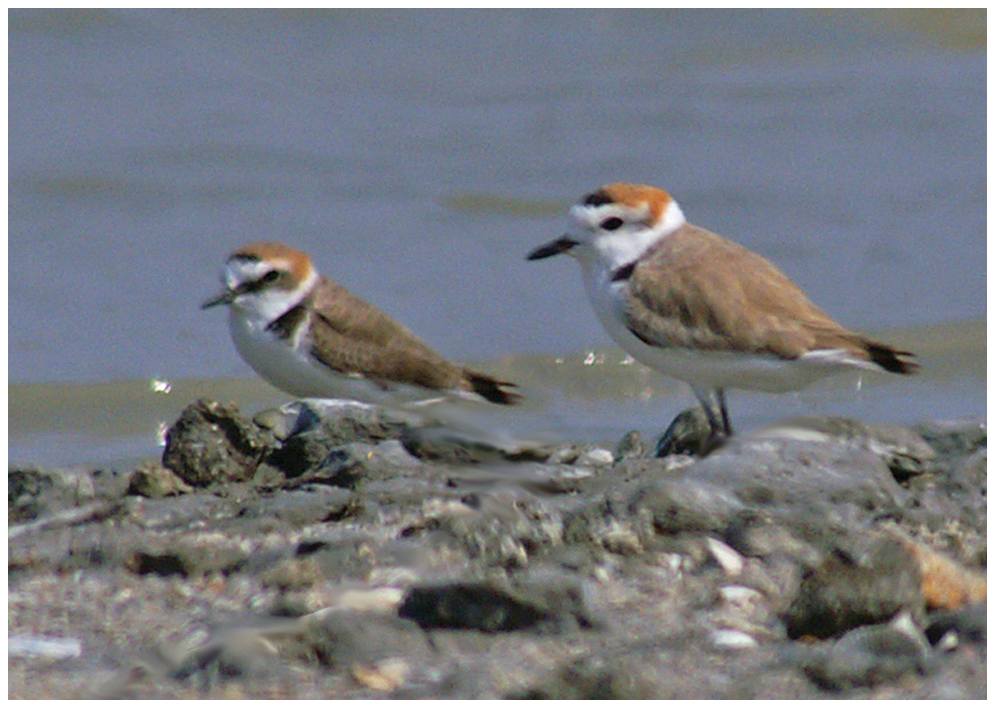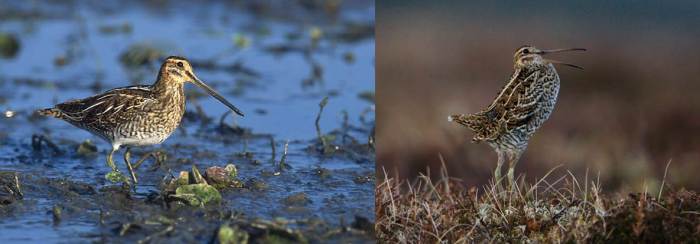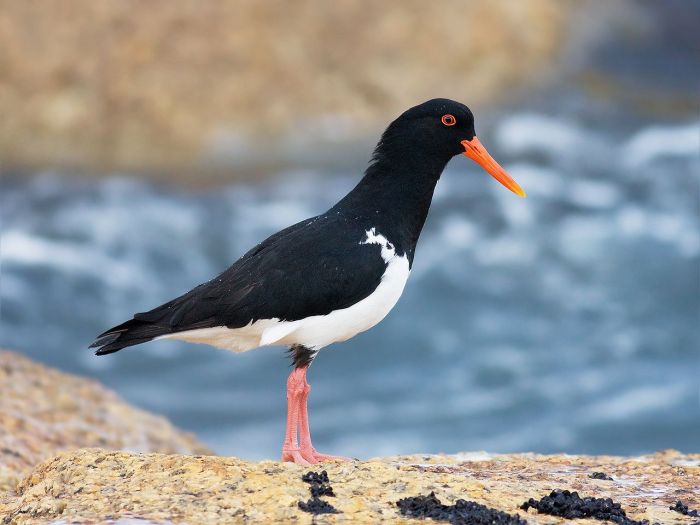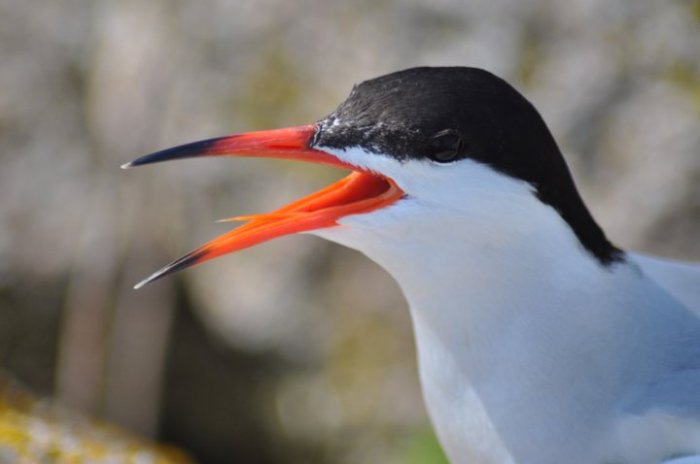This bird order contains small to medium birds. Most of the about 350 species occur near water. They were formerly divided into three suborders: the Charadrii (waders), Lari (gulls) and Alcae (auks). Hybridization occurs in many genera.
Calidris
An apparent hybrid between Dunlin (C. alpina) and White-rumped Sandpiper (C. fuscicollis) was documented in Wisconsin (Anich, 2013).
Charadrius
There might be a hybrid zone between subspecies of the Common Ringed Plover (C. hiaticula), running from Northern Scandinavia to Belarus (Thies et al., 2018).
Several genetic studies uncovered gene flow between Kentish Plover (C. alexandrinus) and White-faced Plover (C. dealbatus), two species that recently established secondary contact (Wang et al., 2019a; Wang et al., 2019b).

Gallinago
In Norway, a hybrid between Great Snipe (G. media) and Common Snipe (G. gallinago) was described, based on behaviour, morphology and genetic data (Höglund et al., 2015).
Haematopus
Several hybrids in this genus have been documented, all based on morphological data:
- Island Pied Oystercatcher (H. finschi) x Variable Oystercatcher (H. unicolor) (Baker, 1975; Crocker, Petch & Sagar, 2010)
- Magellanic Oystercatcher (H. leucopodus) x Blackish Oystercatcher (H. ater) (Jehl, 1978)
- Black Oystercatcher (H. bachmani) x American Oystercatcher (H. palliatus) (Jehl, 1985)
Himantopus
Hybridization between the endemic Black Stilt (H. novaezelandiae) and the Pied Stilt (H. himantopus leucocephalus) is of major conservation concern (Wallis, 1999). The situation has been studied from a morphological (Pierce, 1984) and genetic (Greene, 1999; Steeves et al., 2010) perspective. The most recent study found evidence for extensive hybridization, but not for introgression (Steeves et al., 2010).
In addition, a hybrid between American Avocet (Recurvirostra americana) and Black-necked Stilt (H. mexicanus) is known (Principe, 1977).
Jacana
One study gives a morphological description of a Northern Jacana (J. spinosa) x Wattled Jacana (J. jacana) hybrid (Betts, 1973). A study of the Panamanian hybrid zone between both species revealed introgression from J. jacana into J. spinosa (Miller et al., 2014). Moreover, female body mass, a trait involved in competition between females, has introgressed from Northern into Wattled Jacana (Lipshutz et al., 2019).
Larus
Hybridization is widespread among gulls (Lönnberg, 1919; Smith, 1966). Due to the high frequency of hybridization and the rapid speciation in this bird group, they are genetically closely related (Snell, 1991a), which hampers the construction of phylogenetic trees (Crochet et al., 2003; Crochet, Lebreton & Bonhomme, 2002; Sonsthagen et al., 2016) and leads to the lack of a genetic population structure (Sonsthagen et al., 2012). Gulls were once seen as a classical example of a ring species, but this has been proven incorrect (Liebers, de Knijff & Helbig, 2004).
The Herring Gull complex (Larus argentatus – cachinnans – fuscus) is circumpolar and has been studied extensively in terms of breeding area distribution (Adriaens, Vercruijsse & Stienen, 2012; Filchagov, 1994; Yesou, 1991) and genetic structure (Liebers, Helbig & De Knijff, 2001). Most studies have focused on certain species combinations, always involving the Herring Gull (L. argentatus). Gull species hybridizing with Herring Gull include Yellow-legged Gull (L. michahellis) in the Mediterranean (Pons et al., 2004), Great Black-backed Gull (L. marinus) in North America (Andrle, 1972; Jehl, 1960), Lesser Black-backed Gull (L. fuscus) in Europe (Brown, 1967; Harris, 1970; Harris, Morley & Green, 1978) and North America (Ellis et al., 2014), and Glaucous-winged Gull (L. glaucescens) in North America (Mlodinow; Patten & Weisbrod, 1974; Williamson & Peyton, 1963).
The Iceland Gull complex (L. glaucoides – kumlieni – thayeri) consists of three (sub)species that all interbreed (Gaston & Decker, 1985; McGowan & Kitchener, 2001; Snell, 1989; Weir, Kitchener & McGowan, 2000). Other species combinations that have been studied were Red-billed Gull (L .novaehollandiae) x Black-billed Gull (L. bulleri) in New Zealand (Gurr, 1967) and American Herring Gull (L. smithsonianus) x Great Black-backed Gull (L. marinus) in North America (Pons et al., 2014). The former cross probably resulted in introgression of mtDNA (Mischler et al., 2018; Given et al., 2023).
A few species combinations have received more attention.
Herring Gull (L. argentatus) x Caspian Gull (L. cachinnans)
There are hybrid zones between these species in Poland (Faber et al., 2001; Neubauer et al., 2006) and eastern Europe (Panov & Monzikov, 1999). Genetic studies revealed asymmetric introgression (Gay et al., 2007) and selection on plumage melanism and bare-parts coloration (Gay et al., 2009). The former can be explained by latitude (i.e., Gloger’s Rule), while the latter may be due to sexual selection. Behavioural observations revealed that there is premating isolation due to different breeding phenology and assortative mating according to bare-parts coloration (Neubauer et al., 2009). There is no strong postmating isolation: breeding performance did not differ between pure species and hybrids (Zagalska-Neubauer & Neubauer, 2012). However, female hybrids do seem to have a lower survival rate (Neubauer, Nowicki & Zagalska-Neubauer, 2014).
Herring Gull (L. argentatus) x Glaucous Gull (L. hyperboreus)
Numerous of these hybrids have been reported (Andrle, 1980; Jehl, 1971; Jehl & Frohling, 1965; Spear, 1987). Ingolfsson (1970; 1987) described the hybrid zone on Iceland. However, Snell (1991b) argued that the intermediate plumage was not due to hybridization, but a consequence of light-winged founders in the 1920s. Detailed genetic (and morphological) analyses settled the debate and indicated widespread hybridization (Palsson, Vigfusdottir & Ingolfsson, 2009; Sternkopf et al., 2010; Vigfusdottir, Palsson & Ingolfsson, 2008).
Western Gull (L. occidentalis) x Glaucous-winged Gull (L. glaucescens)
The hybrid zones between these species is located at the coast of Washington and Oregon (Scott, 1971) and has been described from a morphological and genetic perspective (Bell, 1996; Hoffman, Wiens & Scott, 1978). Cline analysis of the hybrid zone detected introgression (Gay et al., 2008), but also (sexual) selection on bare-parts coloration (Gay et al., 2009). The majority of literature on this hybrid zone focuses on breeding success. Bell (1997) found that L. occidentalis has a higher breeding success compared to L. glaucescens and mixed pairs, while Good et al. (2000) documented hybrid superiority. The breeding success of the hybrids was mainly influenced by nest predation, which decreased with increasing vegetation structure around the nest (Good, 2002). However, recent studies did not detect any differences in breeding performance (Megna et al., 2014; Moncrieff et al., 2013).
Pluvialis
While studying the speciation process of American Golden-plover (P. dominica) and Pacific Golden-plover (P. fulva), Withrow and Winker (2014) detected one hybrid individual. Analyses showed that gene flow was close to zero.
Stercorarius
Even though there are only seven skua species (family Stercorariidae), it has been difficult to resolve their phylogeny. Morphological data pointed to two main groups: three species of “jaegers” with pale adult plumage phases and long tails, and four species of dark skuas with short tails (formerly placed in the genus Catharacta). This phenotypic classification was challenged by analyses of the mitochondrial genome. One of the jaeger species – the Pomarine Jaeger (S. pomarinus) – clustered with one of the larger skuas – the Great Skua (S. skua). This pattern is likely the result of capture from the Pomarine Jaeger mtDNA by the Great Skua. Genomic analyses showed that this mitochondrial introgression was accompanied by a substantial amount of nuclear DNA (Mikkelsen & Weir, 2023).
Mikkelsen & Weir (2023) also showed that the Brown Skua (S. antarcticus) contains genetic ancestry from both the Chilean Skua (S. chilensis) and the South Polar Skua (S. maccormicki).

Tribe Sternini (Terns)
Numerous hybrids between various species have been recorded and described, but without any further studies.
- Greater Crested Tern (Thalasseus bergii) x Chinese Crested Tern (Thalasseus bernsteini) (Chen & He, 2011, Yang et al. 2018)
- Little Tern (Sternula albifrons) x fairy tern (Sternula nereis) (Cox & Close, 1977; Ross, Egan & Priddel, 1999)
- Lesser Crested Tern (Thalasseus bengalensis) x Sandwich Tern (Thalasseus sandvicensis) (Dies & Dies, 1998; Steele & McGuigan, 1989; Verroken, 1990)
- Roseate Tern (Sterna dougallii) x Arctic Tern (Sterna paradisaea) (Ewins, 1987; Whittam, 1998)
- Roseate Tern (Sterna dougallii) x Common Tern (Sterna hirundo) (Courtens et al., 2008; Hays, 1975; Robbins, 1974; Zingo, Church & Spendelow, 1994)
Uria
Several observations of hybrids (and backcrosses) between Common Murre (U. aalge) and Thick-billed Murre (U. lomvia) have been reported (Birkhead, Johnson & Nettleship, 1986; Cairns & deYoung, 1981). Reports of hybrids based on morphological characters are often questioned (Cairns, 1983; Sluys, 1983), but a backcross was successfully identified based on molecular data (Friesen et al., 1993). Furthermore, a detailed study detected cryptic introgression between the two species (Taylor et al., 2012).
A possible hybrid between Common Murre and Razorbill (Alca torda) has been reported (Wilhelm et al., 2001).
References
Adriaens, P., Vercruijsse, H. J. & Stienen, E. W. (2012). Hybrid gulls in Belgium—an update. British Birds 105, 530.
Andrle, R. F. (1972). Another probable hybrid of Larus marinus and L. argentatus. The Auk, 669-671.
Andrle, R. F. (1980). 3 More Probable Hybrids of Larus-Hyperboreus and Larus-Argentatus. Wilson Bulletin 92, 389-393.
Anich, N. M. (2013). An Apparent Dunlin × White-rumped Sandpiper Hybrid at Chequamegon Bay, Wisconsin. The Passenger Pigeon 75, 137-146
Baker, A. J. (1975). Morphological variation, hybridization and systematics of New Zealand oystercatchers (Charadriiformes: Haematopodidae). Journal of Zoology 175, 357-390.
Bell, D. A. (1996). Genetic differentiation, geographic variation and hybridization in gulls of the Larus glaucescens-occidentalis complex. Condor 98, 527-546.
Bell, D. A. (1997). Hybridization and reproductive performance in gulls of the Larus glaucescens-occidentalis complex. Condor 99, 585-594.
Betts, B. J. (1973). Possible Hybrid Wattled Jacana X Northern Jacana in Costa-Rica. Auk 90, 687-689.
Birkhead, T., Johnson, S. & Nettleship, D. (1986). Field observations of a possible hybrid murre Uria aalge x Uria lomvia. Canadian Field-Naturalist 100, 115-117.
Brown, R. (1967). Species isolation between Herring Gull Larus argentatus and Lesser Black-backed Gull L. fuscus. Ibis 109, 310-317.
Cairns, D. (1983). Evidence for Hybrid Murre Reconsidered: A Comment. The Auk, 237-238.
Cairns, D. & deYoung, B. (1981). Back-crossing of a Common Murre (Uria aalge) and a Common Murre-Thick-billed Murre hybrid (U. aalge× U. lomvia). The Auk, 847-847.
Chen, L. & He, F. (2011). Are they hybrids of Sterna bergii× Sterna bernsteini? Chinese Birds 2, 152-156.
Courtens, W., Stienen, E. W. M., Van De Walle, M. & Verstraete, H. (2008) Gemengd broedpaar Dougalls Stern met Dougalls X Visdief-hybride in Zeebrugge (België). Sula 21, 123-131.
Cox, J. & Close, D. (1977). Interbreeding of little and fairy terns. Emu 77, 28-32.
Crochet, P. A., Chen, J. J. Z., Pons, J. M., Lebreton, J. D., Hebert, P. D. N. & Bonhomme, F. (2003). Genetic differentiation at nuclear and mitochondrial loci among large white-headed gulls: Sex-biased interspecific gene flow? Evolution 57, 2865-2878.
Crochet, P. A., Lebreton, J. D. & Bonhomme, F. (2002). Systematics of large white-headed gulls: Patterns of mitochondrial DNA variation in western European taxa. Auk 119, 603-620.
Crocker, T., Petch, S. & Sagar, P. (2010). Hybridisation by South Island pied oystercatcher (Haematopus finschi) and variable oystercatcher (H. unicolor) in Canterbury. Notornis 57, 27-32.
Dies, J. & Dies, B. (1998). Hybridisation between Lesser Crested and Sandwich Terns in Valencia, Spain, and plumage of offspring. British Birds 91, 165-170.
Ellis, J. C., Bogdanowicz, S. M., Stoddard, M. C. & Clark, L. W. (2014). Hybridization of a Lesser Black-backed Gull and Herring Gulls in Eastern North America. Wilson Journal of Ornithology 126, 338-345.
Ewins, P. (1987). Probable interbreeding of Roseate and Arctic terns. Scott. Birds 14, 215-216.
Faber, M., Betleja, J., Gwiazda, R. & Malczyk, P. (2001). Mixed colonies of large white-headed gulls in southern Poland. British Birds 94, 529-534.
Filchagov, A. (1994). Contact zones of Larus argentatus–cachinnans–fuscus gull complex in eastern Europe and northern Asia. Journal für Ornithologie 135, 44.
Friesen, V. L., Barrett, R. T., Montevecchi, W. A. & Davidson, W. S. (1993). Molecular-Identification of a Backcross between a Female Common Murre X Thick-Billed Murre Hybrid and a Male Common Murre. Canadian Journal of Zoology-Revue Canadienne De Zoologie 71, 1474-1477.
Gaston, A. & Decker, R. (1985). Interbreeding of Thayers Gull, Larus thayeri, and Kimleins Gull, Larus glaucoides kumleini, on Southampton Island, Northwest Territories. Canadian Field-Naturalist 99, 257-259.
Gay, L., Crochet, P. A., Bell, D. A. & Lenormand, T. (2008). Comparing Clines on Molecular and Phenotypic Traits in Hybrid Zones: A Window on Tension Zone Models. Evolution 62, 2789-2806.
Gay, L., Neubauer, G., Zagalska-Neubauer, M., Debain, C., Pons, J. M., David, P. & Crochet, P. A. (2007). Molecular and morphological patterns of introgression between two large white-headed gull species in a zone of recent secondary contact. Molecular Ecology 16, 3215-3227.
Gay, L., Neubauer, G., Zagalska-Neubauer, M., Pons, J. M., Bell, D. A. & Crochet, P. A. (2009). Speciation with gene flow in the large white-headed gulls: does selection counterbalance introgression? Heredity 102, 133-146.
Given, A. D., Mills, J. A., Momigliano, P., & Baker, A. J. (2023). Molecular evidence for introgressive hybridization in New Zealand masked gulls. Ibis, 165(1), 248-269.
Good, T. P. (2002). Breeding success in the Western Gull x Glaucous-winged Gull complex: The influence of habitat and nest site characteristics. Condor 104, 353-365.
Good, T. P., Ellis, J. C., Annett, C. A. & Pierotti, R. (2000). Bounded hybrid superiority in an avian hybrid zone: Effects of mate, diet, and habitat choice. Evolution 54, 1774-1783.
Greene, B. (1999). Genetic variation and hybridisation of black stilts (Himantopus novaezelandiae) and pied stilts (H-h. leucocephalus), Order Charadriiformes. New Zealand Journal of Zoology 26, 271-277.
Gurr, L. (1967). Interbreeding of Larus novaehollandiae scopulinus and Larus bulleri in the wild in New Zealand. Ibis 109, 552-555.
Harris, M. (1970). Abnormal migration and hybridization of Larus argentatus and L. fuscus after interspecies fostering experiments. Ibis 112, 488-498.
Harris, M., Morley, C. & Green, G. (1978). Hybridization of herring and lesser black-backed gulls in Britain. Bird Study 25, 161-166.
Hays, H. (1975). Probable Common× Roseate Tern hybrids. The Auk, 219-234.
Hoffman, W., Wiens, J. A. & Scott, J. M. (1978). Hybridization between gulls (Larus glaucescens and L. occidentalis) in the Pacific Northwest. The Auk, 441-458.
Höglund, J., Sæther, S. A., Fiske, P., Wheatcroft, D. & Kålås, J. A. (2015). A hybrid snipe Gallinago gallinago× G. media found in the wild. Journal of Ornithology, 1-9.
Ingolfsson, A. (1970). Hybridization of glaucous gulls Larus hyperboreus and herring gulls L. argentatus in Iceland. Ibis 112, 340-362.
Ingolfsson, A. (1987). Hybridization of glaucous and herring gulls in Iceland. Studies on Avian Biology, 131-140.
Jehl, J. (1971). A hybrid Glaucous X Herring Gull from San Diego. Calif. Birds 2, 27-32.
Jehl, J. R. (1960). A probable hybrid of Larus argentatus and L. marinus. The Auk, 343-345.
Jehl, J. R. (1978). New Hybrid Oystercatcher from South-America, Haematopus-Leucopodus X Haematopus-Ater. Condor 80, 344-346.
Jehl, J. R. (1985). Hybridization and evolution of oystercatchers on the Pacific Coast of Baja California. Ornithological Monographs, 484-504.
Jehl, J. R. & Frohling, R. C. (1965). 2 Probable Hybrid Gulls from New Jersey. Auk 82, 498-&.
Liebers, D., de Knijff, P. & Helbig, A. J. (2004). The herring gull complex is not a ring species. Proceedings of the Royal Society B-Biological Sciences 271, 893-901.
Liebers, D., Helbig, A. J. & De Knijff, P. (2001). Genetic differentiation and phylogeography of gulls in the Larus cachinnans-fuscus group (Aves : Charadriiformes). Molecular Ecology 10, 2447-2462.
Lipshutz, S.E., Meier, J.I., Derryberry, G.E., Miller, M.J., Seehausen, O. & Derryberry, E.P. (2019) Differential introgression of a female competitive trait in a hybrid zone between sex-role reversed species. Evolution.
Lönnberg, A. J. E. (1919). Hybrid gulls. Almqvist & Wiksells Boktryckeri.
McGowan, R. Y. & Kitchener, A. C. (2001). Historical and taxonomic review of the Iceland Gull Larus glaucoides complex. British Birds 94, 191-195.
Megna, L. C., Moncrieff, A. E., Hayward, J. L. & Henson, S. M. (2014). Equal reproductive success of phenotypes in the Larus glaucescens–occidentalis complex. Journal of Avian Biology 45, 410-416.
Mikkelsen, E. K., & Weir, J. T. (2023). Phylogenomics Reveals that Mitochondrial Capture and Nuclear Introgression Characterize Skua Species Proposed to be of Hybrid Origin. Systematic Biology, 72(1), 78-91.
Miller, M. J., Aguilar, C., De León, L. F., Loaiza, J. R. & McMillan, W. O. (2014). Complete mitochondrial genomes of the New World jacanas: Jacana spinosa and Jacana jacana. Mitochondrial DNA, 1-2.
Miller, M. J., Lipshutz, S. E., Smith, N. G. & Bermingham, E. (2014b). Genetic and phenotypic characterization of a hybrid zone between polyandrous Northern and Wattled Jacanas in Western Panama. Bmc Evolutionary Biology 14.
Mischler, C., Veale, A., van Stijn, T., Brauning, R., McEwan, J.C., Maloney, R. & Robertson, B.C. (2018) Population Connectivity and Traces of Mitochondrial Introgression in New Zealand Black-billed Gulls (Larus bulleri). Genes 9, 544.
Mlodinow, S. G. Stealth Gull: Herring× Glaucous-winged Gull Hybrids in the North American Interior. Colorado Birds 46, 198-206.
Moncrieff, A. E., Megna, L. C., Hayward, J. L. & Henson, S. M. (2013). Mating patterns and breeding success in gulls of the Larus glaucescens-occidentalis complex, Protection Island, Washington, USA. Northwestern Naturalist 94, 67-75.
Neubauer, G., Nowicki, P. & Zagalska-Neubauer, M. (2014). Haldane’s rule revisited: do hybrid females have a shorter lifespan? Survival of hybrids in a recent contact zone between two large gull species. Journal of Evolutionary Biology 27, 1248-1255.
Neubauer, G., Zagalska-Neubauer, M., Gwiazda, R., Faber, M., Bukaciinski, D., Betleja, J. & Chylarecki, P. (2006). Breeding large gulls in Poland: distribution, numbers, trends and hybridisation. VOGELWELT-BERLIN- 127, 11.
Neubauer, G., Zagalska-Neubauer, M. M., Pons, J. M., Crochet, P. A., Chylarecki, P., Przystalski, A. & Gay, L. (2009). Assortative Mating without Complete Reproductive Isolation in a Zone of Recent Secondary Contact between Herring Gulls (Larus Argentatus) and Caspian Gulls (L. Cachinnans). Auk 126, 409-419.
Palsson, S., Vigfusdottir, F. & Ingolfsson, A. (2009). Morphological and Genetic Patterns of Hybridization of Herring Gulls (Larus Argentatus) and Glaucous Gulls (L. Hyperboreus) in Iceland. Auk 126, 376-382.
Panov, E. & Monzikov, D. (1999). Intergradation between the herring gull Larus argentatus and the southern herring gull Larus cachinnans in European Russia. Russian Journal of Zoology 3, 129-141.
Patten, S. & Weisbrod, A. (1974). Sympatry and interbreeding of Herring and Glaucous-winged Gulls in southeastern Alaska. Condor, 343-344.
Pierce, R. (1984). Plumage, morphology and hybridisation of New Zealand stilts Himantopus spp. Notornis 31, 130.
Pons, J. M., Crochet, P. A., Thery, M. & Bermejo, A. (2004). Geographical variation in the yellow-legged gull: introgression or convergence from the herring gull? Journal of Zoological Systematics and Evolutionary Research 42, 245-256.
Pons, J. M., Sonsthagen, S., Dove, C. & Crochet, P. A. (2014). Extensive mitochondrial introgression in North American Great Black-backed Gulls (Larus marinus) from the American Herring Gull (Larus smithsonianus) with little nuclear DNA impact. Heredity (Edinb) 112, 226-39.
Principe, W. L. (1977). A hybrid American Avocet× Black-necked Stilt. Condor, 128-129.
Robbins, C. (1974). Probable interbreeding of common and roseate terns. Brit. Birds 67, 168-170.
Ross, G., Egan, K. & Priddel, D. (1999). Hybridization between Little Tern Sterna albifrons and Fairy Tern Sterna nereis in Botany Bay, New South Wales. Corella 23, 33-36.
Scott, J. M. (1971). Interbreeding of the glaucous-winged gull and western gull in the Pacific northwest. Calif. Birds 2, 133.
Sluys, R. (1983). Evidence for hybrid murre reconsidered. The Auk, 236-237.
Smith, N. G. (1966). Evolution of some arctic gulls (Larus): an experimental study of isolating mechanisms. Ornithological Monographs, 1-99.
Snell, R. R. (1989). Status of Larus Gulls at Home Bay, Baffin Island. Colonial Waterbirds 12, 12-23.
Snell, R. R. (1991a). Interspecific Allozyme Differentiation among North-Atlantic White-Headed Larid Gulls. Auk 108, 319-328.
Snell, R. R. (1991b). Variably Plumaged Icelandic Herring-Gulls Reflect Founders Not Hybrids. Auk 108, 329-341.
Sonsthagen, S. A., Chesser, R. T., Bell, D. A. & Dove, C. J. (2012). Hybridization among Arctic white-headed gulls (Larus spp.) obscures the genetic legacy of the Pleistocene. Ecology and Evolution 2, 1278-1295.
Sonsthagen, S. A., Wilson, R. E., Chesser, R. T., Pons, J. M., Crochet, P. A., Driskell, A. & Dove, C. (2016). Recurrent hybridization and recent origin obscure phylogenetic relationships within the ‘white-headed’ gull (Larus sp.) complex. Molecular Phylogenetics and Evolution 103, 41-54.
Spear, L. B. (1987). Hybridization of glaucous and herring gulls at the Mackenzie Delta, Canada. The Auk, 123-125.
Steele, J. & McGuigan, C. (1989). Plumage features of a hybrid juvenile Lesser Crested X Sandwich tern. Birding World 2, 391-392.
Steeves, T. E., Maloney, R. F., Hale, M. L., Tylianakis, J. M. & Gemmell, N. J. (2010). Genetic analyses reveal hybridization but no hybrid swarm in one of the world’s rarest birds. Molecular Ecology 19, 5090-5100.
Sternkopf, V., Liebers-Helbig, D., Ritz, M. S., Zhang, J., Helbig, A. J. & de Knijff, P. (2010). Introgressive hybridization and the evolutionary history of the herring gull complex revealed by mitochondrial and nuclear DNA. Bmc Evolutionary Biology 10.
Taylor, S. A., Patirana, A., Birt, T. & Friesen, V. (2012). Cryptic introgression between murre sister species (Uria spp.) in the Pacific low Arctic: frequency, cause, and implications. Polar Biology 35, 931-940.
Thies, L., Tomkovich, P., dos Remedios, N, Lislevand, T., Pinchuk, P., Wallander, J., Dänhardt, J., þórisson, B., Blomqvist, D & Küpper, C. (2018) Population and Subspecies Differentiation in a High Latitude Breeding Wader, the Common Ringed Plover Charadrius hiaticula. Ardea 106(2), 163-176.
Verroken, L. (1990). Presumed hybrid Sandwich x Lesser Crested Tern. Birding World 3, 418-419.
Vigfusdottir, F., Palsson, S. & Ingolfsson, A. (2008). Hybridization of glaucous gull (Larus hyperboreus) and herring gull (Larus argentatus) in Iceland: mitochondrial and microsatellite data. Philosophical Transactions of the Royal Society B-Biological Sciences 363, 2851-2860.
Wallis, G. (1999). Genetic status of New Zealand black stilt (Himantopus novaezelandiae) and impact of hybridisation. Department of Conservation Wellington.
Wang, X., Que, P., Heckel, G., Hu, J., Zhang, X., Chiang, C. Y., et al. (2019). Genetic, phenotypic and ecological differentiation suggests incipient speciation in two Charadrius plovers along the Chinese coast. BMC Evolutionary Biology, 19(1), 135.
Wang, X., Maher, K. H., Zhang, N., Que, P., Zheng, C., Liu, S., et al. (2019). Demographic histories and genome-wide patterns of divergence in incipient species of shorebirds. Frontiers in Genetics, 10, 919.
Weir, D. N., Kitchener, A. C. & McGowan, R. Y. (2000). Hybridization and changes in the distribution of Iceland gulls (Larus glaucoides kumlieni/thayeri). Journal of Zoology 252, 517-530.
Whittam, R. M. (1998). Interbreeding of roseate and arctic terns. The Wilson Bulletin, 65-70.
Wilhelm, S., Walsh, C., Stenhouse, I. & Storey, A. (2001). A possible common guillemot (Uria aalge) X razorbill (Alca torda) hybrid. Atl. Seabirds 3, 85-88.
Williamson, F. S. & Peyton, L. J. (1963). Interbreeding of Glaucous-winged and Herring gulls in the Cook Inlet region, Alaska. Condor, 24-28.
Withrow, J. J. & Winker, K. (2014). Genetics of a High-Latitude Cryptic Speciation Event: American and Pacific Golden-Plovers. Wilson Journal of Ornithology 126, 429-442.
Yang, J., Chen, G., Yuan, L., Huang, Q., Fan, Z., Lu, Y., Liu, Y. & Chen, S. (2018) Genetic evidence of the world’s most endangered tern, the Chinese Crested Tern Thalasseus bernsteini. Ibis
Yesou, P. (1991). The sympatric breeding of Larus fuscus, L. cachinnans and L. argentatus in western France. Ibis 133, 256-263.
Zagalska-Neubauer, M. & Neubauer, G. (2012). Reproductive performance and changes in relative species abundance in a mixed colony of Herring and Caspian Gulls, Larus argentatus and Larus cachinnans. Acta Ornithologica 47, 185-194.
Zingo, J., Church, C. & Spendelow, J. (1994). Two hybrid common x roseate terns fledge at Falkner Island, Connecticut. The Connecticut Warbler 14, 50-55.
* The Larus text has been reviewed by Grzegorz Neubauer (Polish Academy of Sciences, Warsaw)










[…] Charadriiformes […]
[…] Charadriiformes […]
[…] Charadriiformes […]
[…] Charadriiformes […]
[…] Charadriiformes […]